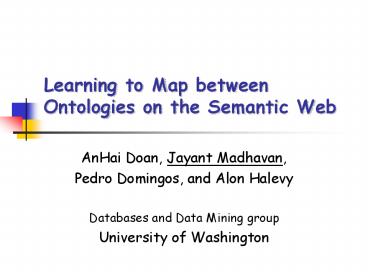Learning to Map between Ontologies on the Semantic Web - PowerPoint PPT Presentation
Title:
Learning to Map between Ontologies on the Semantic Web
Description:
Learning to Map between Ontologies on the Semantic Web. AnHai ... CLAN. A. Content Learner. Frequencies on different words in the text in the data instances ... – PowerPoint PPT presentation
Number of Views:180
Avg rating:3.0/5.0
Title: Learning to Map between Ontologies on the Semantic Web
1
Learning to Map between Ontologies on the
Semantic Web
- AnHai Doan, Jayant Madhavan,
- Pedro Domingos, and Alon Halevy
- Databases and Data Mining group
- University of Washington
2
Semantic Web
- Mark-up data on the web using ontologies
- Enable intelligent information processing over
the web - Personal software agents
- Queries over multiple web pages
3
An Example
www.cs.washington.edu
www.cs.usyd.edu.au
- Find Prof. Cook, a professor in a Seattle
college, earlier an assoc. professor at his alma
mater in Australia
Semantic Mappings allow information processing
across ontologies
4
Semantic Web State of the Art
- Languages for ontologies
- RDF, DAMLOIL,
- Ontology learning and Ontology design tools
- Maedche02, Protégé, Ontolingua,
- Semantic Mappings crucial to the SW vision
- Uscold01, Berners-Lee, et al.01
Without semantic mappingsTower of Babel !!!
5
Semantic Mapping Challenges
- Ontologies can be very different
- Different vocabularies, different design
principles - Overlap, but not coincide
- Semantic Mapping information
- Data instances marked up with ontologies
- Concept names and taxonomic structure
- Constraints on the mapping
6
Overview
People
Staff
Staff
Faculty
Academic
Technical
Faculty
Lecturer
Professor
Senior Lecturer
Asst. Professor
Professor
Assoc. Professor
Define Similarity
7
Our Contributions
- An automatic solution to taxonomy matching
- Handles different similarity notions
- Exploits information in data instances and
taxonomic structure, using multi-strategy
learning - Extend solution to handle wide variety of
constraints, using Relaxation Labeling - An implementation, our GLUE system, and
experiments on real-world taxonomies - High accuracy (68-98) on large taxonomies
(100-330 concepts)
8
Defining Similarity
Snr. Lecturer
Assoc. Prof
Hypothetical Common Marked up domain
Joint Probability Distribution
P(A,S),P(?A,S),P(A,?S),P(?A,?S)
- Multiple Similarity measures in terms of the JPD
9
No common data instances
- In practice, not easy to find data tagged with
both ontologies !
United States
Australia
Solution Use Machine Learning
10
Machine Learning for computing similarities
United States
Australia
- JPD estimated by counting the sizes of the
partitions
11
Improve Predictive Accuracy Use Multi-Strategy
Learning
- Single Classifier cannot exploit all available
information - Combine the prediction of multiple classifiers
A
Meta-Learner
CLA1
A
?A
A
?A
CLAN
?A
Content Learner Frequencies on different words
in the text in the data instances Name
Learner Words used in the names of concepts in
the taxonomy Others
12
So far
Define Similarity
Joint Probability Distribution
Multi-strategy Learning
13
Next Step Exploit Constraints
- Constraints due to the taxonomy structure
- Domain specific constraints
- Department-Chair can only map to a unique concept
- Numerous constraints of different types
Staff
People
Staff
Fac
Acad
Tech
Prof
Lect.
Assoc. Prof
Asst. Prof
Prof
Snr. Lect.
Extended Relaxation Labeling to ontology matching
14
Solution Relaxation Labeling
- Find the best label assignment given a set of
constraints
Staff
People
Acad
Staff
Fac
Tech
Fac
Prof
Lect.
Assoc. Prof
Asst. Prof
Prof
Snr. Lect.
- Start with an initial label assignment
- Iteratively improves labels, given constraints
- Standard Relaxation Labeling not applicable
- Extended in many ways
15
Putting it all together GLUE System
16
Real World Experiments
- Taxonomies on the web
- University classes (UW and Cornell)
- Companies (Yahoo and The Standard)
- For each taxonomy
- Extracted data instances course descriptions,
and company profiles - Trivial data cleaning
- 100 300 concepts per taxonomy
- 3-4 depth of taxonomies
- 10-90 average data instances per concept
- Evaluation against manual mappings as the gold
standard
17
Results
University I
University II
Companies
18
Related Work
- Our LSD schema matching system Doan, Domingos,
Halevy 01 - GLUE handles taxonomies, richer models, and a
much richer set of constraints - Other Ontology and Schema Matching work Noy,
Musen01, Melnik, et al.02, Ichise, et
al.01 - Mostly heuristics, or single machine learning
techniques - Relaxation Labeling for constraint satisfaction
Hummel, Zucker83, Chakrabarti, et al.00 - Significantly extend this approach
19
Conclusions Future Work
- An automated solution to taxonomy matching
- Handles multiple notions of similarity
- Exploits data instances and taxonomy structure
- Incorporates generic and domain-specific
constraints - Produces high accuracy results
- Future Work
- More expressive models
- Complex Mappings
- Automated reasoning about mappings between models
20
An Example
www.cs.washington.edu
www.cs.usyd.edu.au
- Find Prof. Cook, a professor in a Seattle
college, earlier an assoc. professor at his alma
mater in Australia
Semantic Mappings allow information processing
across ontologies
21
Solution Relaxation Labeling
- Iterative estimation of most likely label
assignment
Staff
People
Acad
Staff
Fac
Tech
Prof
Lect.
Assoc. Prof
Asst. Prof
Prof
Snr. Lect.
- Challenges
- Making the computation tractable large number
of labels - Combining effects of various constraints
22
Languages for Ontologies E.g. DAMLOIL
Ontology Design Tools E.g. Protégé, Ontolingua,
Semantic Mapping































